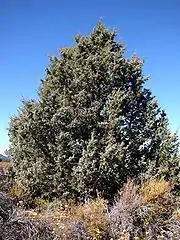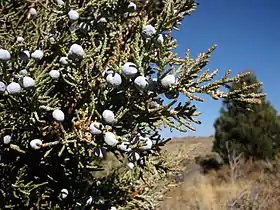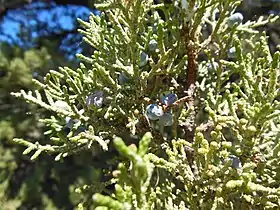Juniperus occidentalis
Juniperus occidentalis, known as the western juniper, is a shrub or tree native to the western United States, growing in mountains at altitudes of 800–3,000 metres (2,600–9,800 ft) and rarely down to 100 metres (330 ft). It is listed as Least Concern on the IUCN Red List because it is a widespread species with an increasing population.[1]
| Juniperus occidentalis | |
|---|---|
 | |
| At Lava Beds National Monument | |
| Scientific classification | |
| Kingdom: | Plantae |
| Clade: | Tracheophytes |
| Division: | Pinophyta |
| Class: | Pinopsida |
| Order: | Pinales |
| Family: | Cupressaceae |
| Genus: | Juniperus |
| Species: | J. occidentalis |
| Binomial name | |
| Juniperus occidentalis | |
 | |
| Natural range in dark green (light green is Juniperus grandis) | |
Description
Juniperus occidentalis shoots are of moderate thickness among junipers, at 1–1.6 mm diameter. The leaves are arranged in opposite decussate pairs or whorls of three; the adult leaves are scale-like, 1–2 mm long (to 5 mm on lead shoots) and 1–1.5 mm broad. The juvenile leaves (on young seedlings only) are needle-like, 5–10 mm long. The cones are berry-like, 5–10 mm in diameter, blue-brown with a whitish waxy bloom, and contain one to three seeds; they are mature in about 18 months. The male cones are 2–4 mm long, and shed their pollen in early spring.
.jpg.webp) Form
Form Berry-like female cones
Berry-like female cones Leaves and cones
Leaves and cones
Taxonomy
The Sierra juniper, Juniperus grandis, is sometimes treated as a subspecies or variety of J. occidentalis (as J. occidentalis var. australis).[2][3] The two species are distinguished by range, form, as well as essential oil and genetic evidence.[4]
- Juniperus occidentalis. Southeast Washington, eastern and central Oregon, southwest Idaho, northeastern California and extreme northwest Nevada, north of 40° 30' N latitude, east of the Cascade Range. A shrub or small tree 4–15 m tall. Exceptionally tall specimens can be found in the John Day area of Oregon well in excess of 26–28 m (85–92 ft) tall where they compete for sunlight among ponderosa pines at the bottom of some deep side canyons. Howerver, on open and barren ground 4–15 m with a bushier growth habit is more common. Cones 7–10 mm diameter. About 50% of plants are monoecious with both sexes on the same plant, 50% dioecious, producing cones of only one sex.
- Juniperus grandis. California and westernmost Nevada, south of 40° 30' N latitude in the Sierra Nevada and San Bernardino Mountains. A medium-sized tree 12–26 m tall with a stout trunk up to 3 m diameter. Cones 5–9 mm diameter. Most plants dioecious, but about 5–10% are monoecious. The Bennett Juniper in the Stanislaus National Forest of California is considered the oldest and largest example at possibly 3000 years old, with a height of 26 m and a diameter of 3.88 m.[5]
Habitat
Juniperus occidentalis usually occurs on dry, rocky sites where there is less competition from larger species like ponderosa pine and coast Douglas-fir. In very exposed positions at high altitude, they can assume a krummholz habit, growing low to the ground even when mature with a wide trunk. Hybrids with Juniperus osteosperma are occasionally found.
Ecology
The cones are an important food for several birds, including American robin, Clark's nutcracker, phainopepla and cedar waxwing; these digest the fleshy cone scales and disperse the seeds in their droppings.
The plants often bear galls caused by the juniper tip midge, Oligotrophus betheli. These are violet-purple fading to brown, 1–2 cm diameter, with dense modified spreading scale-leaves 6–10 mm long and 2–3 mm broad at the base.
Seasonal development
Springtime is when the majority of western juniper seed germinate. In Oregon, where most of the western juniper trees reside, seeds germinate in April and foliage of the plant emerges in June.[6] For seeds to be dispersed, water runoff, gravity, and animals dispersing seeds, all contribute to the distribution of the seeds.[6]
Fire ecology
In the past two decades, sagebrush steppe ecosystems have witnessed an expansion of Juniper throughout the Western United States.[7] This alteration of vegetation change can be associated with the decreased fire frequency, overgrazing of livestock, and an alteration of climate that transformed into a more wet and mild climate.[7]
Fire scar data was collected and dated to display the expansion of western juniper. It started between 1875 and 1885, with a pinnacle rate of development between approximately 1905 and 1924.[7]
Since the 1990s use of prescribed fires to control expansion of western juniper has increased. The results of increased prescription fires show a positive correlation of plant communities post fire.[8]
References
- Farjon, A. (2013). "Juniperus occidentalis". IUCN Red List of Threatened Species. 2013: e.T42242A2965783. doi:10.2305/IUCN.UK.2013-1.RLTS.T42242A2965783.en.
- "Juniperus grandis R.P. Adams". Plants of the World Online. Royal Botanical Gardens Kew. Retrieved 9 July 2019.
- Flora of North America: Juniperus occidentalis
- Adams, R. P., S. Nguyen, J. A. Morris and A. E. Schwarzbach. 2006. Re-examination of the taxonomy of the one-seeded, serrate leaf Juniperus of southwestern United States and northern Mexico (Cupressaceae). Phytologia 88(3):299–310.
- "Conifers.org Australis". Archived from the original on 2006-06-30. Retrieved 2006-08-05.
- "Juniperus occidentalis". www.fs.fed.us. Retrieved 2020-11-24.
- Miller, R. F.; Rose, J. A. (1999-11-01). "Fire history and western juniper encroachment in sagebrush steppe". Rangeland Ecology & Management / Journal of Range Management Archives. 52 (6): 550–559. ISSN 1550-7424.
- Miller, Bates, Svejar, Pierson, Richard, Johanthan, Tony, Frederick (January 2005). "Rangeland Ecology and Management of Western Juniper". Research Gate.CS1 maint: multiple names: authors list (link)
Further reading
| Wikimedia Commons has media related to Juniperus occidentalis. |
- Adams, R. P. (2004). Junipers of the World: The genus Juniperus. Trafford Publishing ISBN 1-4120-4250-X
- Chase, J. Smeaton (1911). "Juniperus occidentalis (Sierra-juniper, Western-juniper)". Cone-bearing Trees of the California Mountains. Eytel, Carl (illustrations). Chicago: A.C. McClurg & Co. pp. 92–95. LCCN 11004975. OCLC 3477527.

